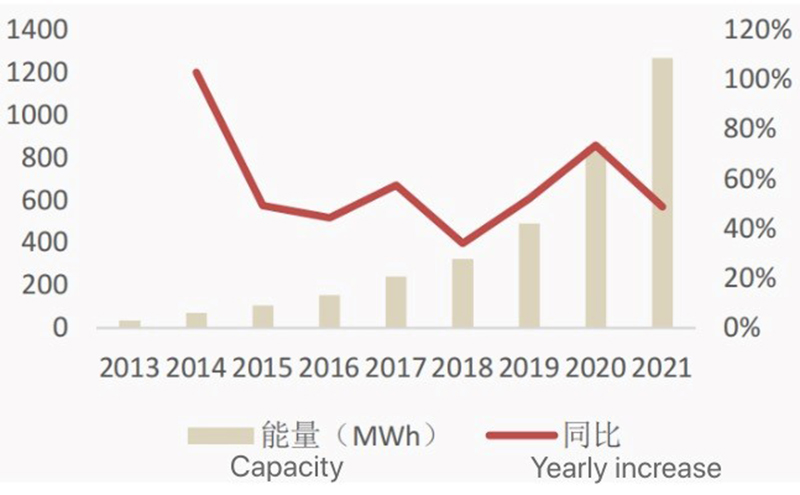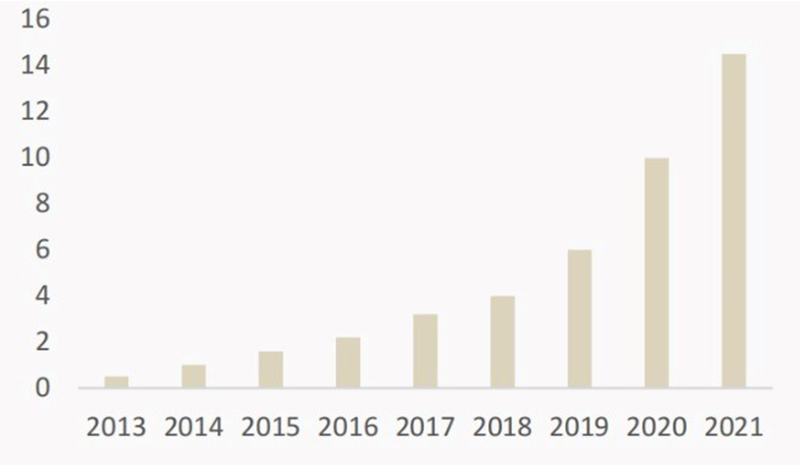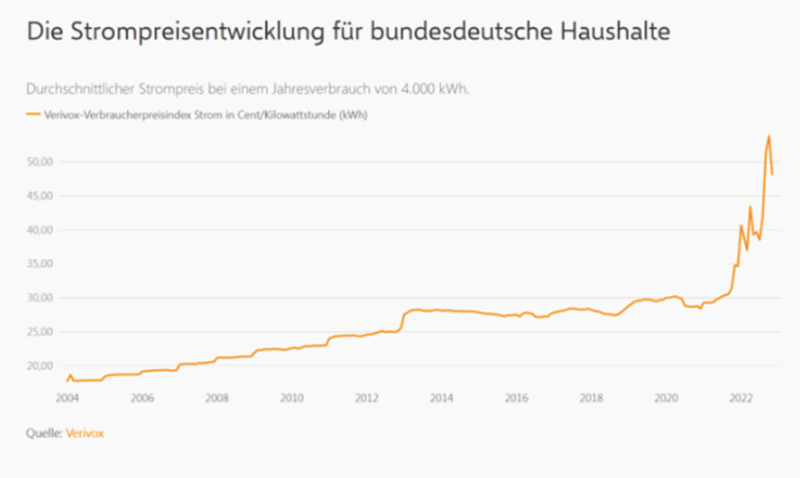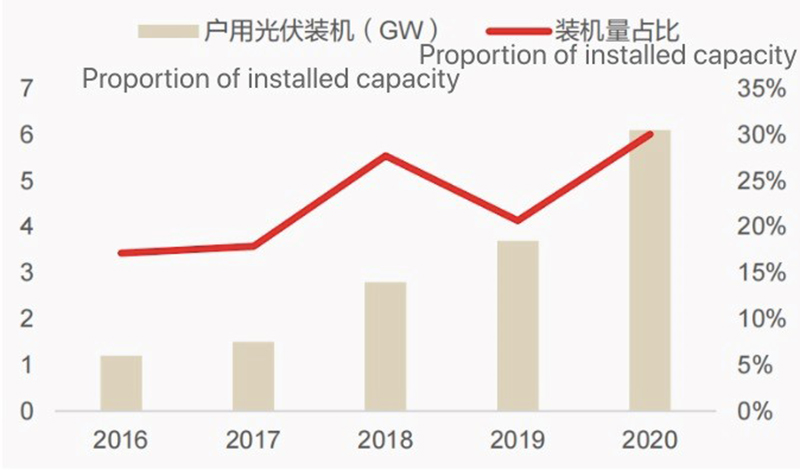Since 2021, the European market has been affected by rising energy prices, the price of residential electricity has risen rapidly, and the economy of energy storage has been reflected, and the market is booming. Looking back to 2022, the conflict between Russia and Ukraine has exacerbated energy anxiety. Driven by the sense of crisis, the demand for household energy storage will continue to grow. Looking forward to 2023, the global energy transformation is the general trend, and household energy self-use is the main way. The global electricity price has entered a rising channel, the economy of household energy storage has been realized, and the market space will continue to grow in the future.
Looking back on 2022:
European energy crisis, rapid growth of household energy storage
The vast majority of household energy storage is used in conjunction with household distributed photovoltaics. In 2015, the annual newly installed capacity of household energy storage in the world was only about 200MW. By 2020, the global new installed capacity reached at 1.2GW, a year-on-year increase of 30%.
In 2021, the European market will be affected by the rise in energy prices, and the price of electricity for residents will rise rapidly. The economics of energy storage will be reflected, and the market will be booming. Taking Germany as an example, 145,000 sets of household photovoltaics were added in 2021, with an installed capacity of 1.268GWh, a year-on-year increase of +49%.
Figure: New installed capacity of household energy storage in Germany (MWh)
Figure: New additions of household energy storage systems in Germany (10,000 households)
The reason for the rapid growth of household energy storage in Europe in 2022 comes from the demand for energy independence under the influence of the Russia-Ukraine conflict and the rise in electricity prices has improved the economics of household energy storage.
Excessive dependence on foreign energy has brought about an energy crisis, and the conflict between Russia and Ukraine has exacerbated energy anxiety. According to the “BP World Energy Statistical Yearbook”, fossil energy accounts for a high proportion of European energy structure, and natural gas accounts for about 25%. Moreover, natural gas is highly dependent on foreign countries, and about 80% comes from imported pipelines and liquefied natural gas, of which imported pipelines from Russia Natural gas has 13 billion cubic feet per day, accounting for 29% of the total supply.
Due to geopolitical conflicts, Russia has stopped supplying natural gas to Europe, threatening energy supply in Europe. In order to reduce energy dependence on Russia and maintain energy security, European governments have introduced policies to develop clean energy and accelerate the pace of energy transformation to ensure energy supply.
Figure: European Energy Consumption Structure
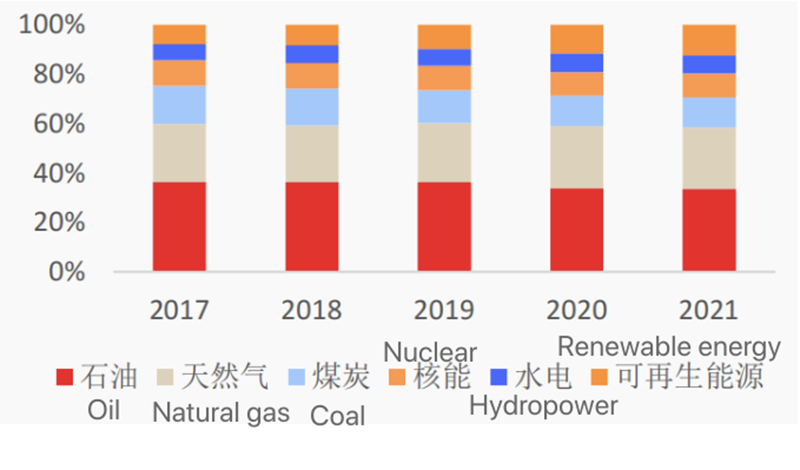 The reason for the rapid growth of household energy storage in Europe in 2022 comes from the demand for energy independence under the influence of the Russia-Ukraine conflict and the rise in electricity prices has improved the economics of household energy storage.
The reason for the rapid growth of household energy storage in Europe in 2022 comes from the demand for energy independence under the influence of the Russia-Ukraine conflict and the rise in electricity prices has improved the economics of household energy storage.
Excessive dependence on foreign energy has brought about an energy crisis, and the conflict between Russia and Ukraine has exacerbated energy anxiety. According to the “BP World Energy Statistical Yearbook”, fossil energy accounts for a high proportion of European energy structure, and natural gas accounts for about 25%. Moreover, natural gas is highly dependent on foreign countries, and about 80% comes from imported pipelines and liquefied natural gas, of which imported pipelines from Russia Natural gas has 13 billion cubic feet per day, accounting for 29% of the total supply.
Due to geopolitical conflicts, Russia has stopped supplying natural gas to Europe, threatening energy supply in Europe. In order to reduce energy dependence on Russia and maintain energy security, European governments have introduced policies to develop clean energy and accelerate the pace of energy transformation to ensure energy supply.
Figure: European Energy Consumption Structure
The reason for the rapid growth of household energy storage in Europe in 2022 comes from the demand for energy independence under the influence of the Russia-Ukraine conflict and the rise in electricity prices has improved the economics of household energy storage.
Excessive dependence on foreign energy has brought about an energy crisis, and the conflict between Russia and Ukraine has exacerbated energy anxiety. According to the “BP World Energy Statistical Yearbook”, fossil energy accounts for a high proportion of European energy structure, and natural gas accounts for about 25%. Moreover, natural gas is highly dependent on foreign countries, and about 80% comes from imported pipelines and liquefied natural gas, of which imported pipelines from Russia Natural gas has 13 billion cubic feet per day, accounting for 29% of the total supply.
Due to geopolitical conflicts, Russia has stopped supplying natural gas to Europe, threatening energy supply in Europe. In order to reduce energy dependence on Russia and maintain energy security, European governments have introduced policies to develop clean energy and accelerate the pace of energy transformation to ensure energy supply.
Figure: European Energy Consumption Structure
Global utility power prices enter a rising channel
The economics of household energy storage are clear
Residential electricity prices are mainly composed of energy costs, grid access fees, and related taxes and fees, of which energy costs (that is, the on-grid electricity prices of power plants) only account for 1/3 of the terminal electricity cost. Energy prices have risen this year, leading to an increase in electricity prices.
Residential electricity prices adopt the annual package method, and there is a certain lag in the transmission of electricity price increases, but the trend of electricity price increases is obvious. Currently, the unit price of one-year electricity package for residents in the German market has risen to about 0.7 euros/kwh. The high cost of electricity has stimulated the demand of residents to achieve energy independence and save electricity bills by installing household photovoltaic + energy storage systems.
Calculate the installed capacity of distributed photovoltaics based on the number of households, consider the penetration rate of household energy storage to obtain the number of installed household energy storage, and assume the average installed capacity per household to obtain the installed capacity of household energy storage in the world and in various markets. We predict that the global household energy storage capacity space will reach 57.66GWh in 2025, with a compound growth rate of 91% from 2021 to 2025. Among them, the European market is the largest, with a new installed capacity of 41.09GWh in 2025, with a compound growth rate of 112%; The additional installed capacity was 7.90GWh, with a compound growth rate of 71%.
The household energy storage track has been called the golden track by the industry. The core driving force for the rapid growth of household energy storage comes from the fact that household energy storage can improve the efficiency of self-generated electricity and reduce economic costs. Driven by global energy inflation and geopolitical conflicts in some regions, global household energy storage has pressed the fast-forward button for development.
Driven by the high boom in European household storage, many manufacturers have poured into the household energy storage industry, and some companies have fully benefited from the rise of the household energy storage industry. Those who have benefited the most are enterprises that have entered into household energy storage systems, batteries, and inverters earlier, and have achieved geometric growth in performance.
Post time: Nov-25-2022


